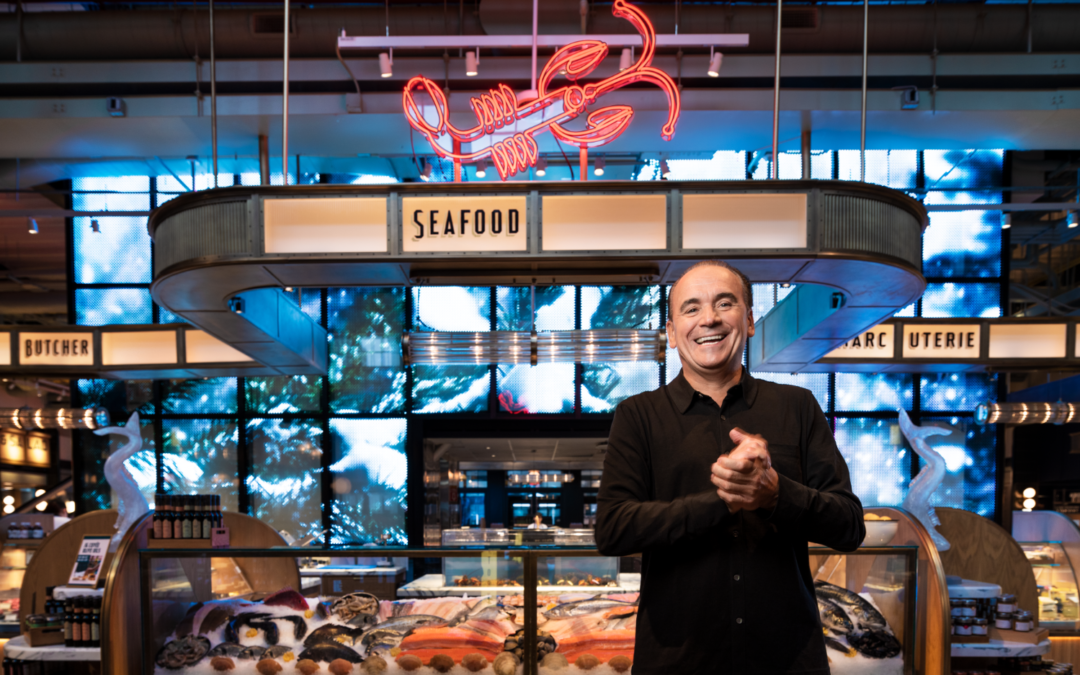Jean-Georges Vongerichten’s Tin Building, a colossal food market and dining destination, now open at The Seaport, is a labor of love nearly a decade in the making.
Repost from WINTER 2023 issue
Photography by Andrea Fremiotti
Creative Direction by Deborah Dragon
CELEBRATED CHEF AND RESTAURATEUR JEAN-GEORGES VONGERICHTEN PLANTED HIS FLAG IN THE GROUND AT THE SEAPORT WITH THE FULTON, a paean to seafood befitting the former site of the Fulton Street Fish Market. Last summer he expanded his footprint with the opening of the Tin Building, a 53,000 square foot market and culinary destination, embraced by Downtown residents, as well as gastronomes around the world.
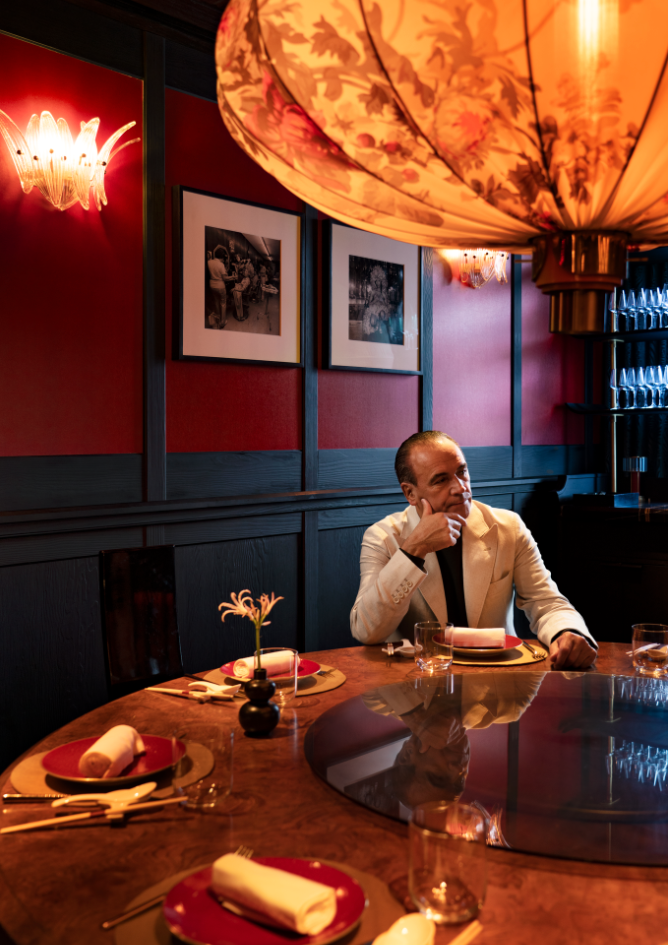
JOY IN THE PRIVATE DINING ROOM at the House of the Red Pearl. Brunello Cucinelli jacket. Brunello Cucinelli 136 Greene Street, New York, NY 10001; UNIQLO crew neck t-shirt. uniqlo.com
“It means a lot to me,” says Jean-Georges who, born and trained in France, established a global name in Asia and has declared New York his home. “When I first came to New York, I used to buy fish at this building in the Seaport for my restaurants. It’s wonderful to see the Seaport reborn this way.”
When The Fulton opened its doors on Pier 17 in 2019, it quickly became regarded as a mandatory seafood dining destination — not only for Downtown residents, but the global audience of tourists and culinarians from all over the world. “JG has been such a great mentor,” says The Fulton’s Chef de Cuisine, Lei Jiang. “He is always giving me advice on new dishes, ingredients, and what he finds in the market. I believe being a chef, the most important thing you can do is pass on knowledge to the next generation of chefs, which he is always doing.”
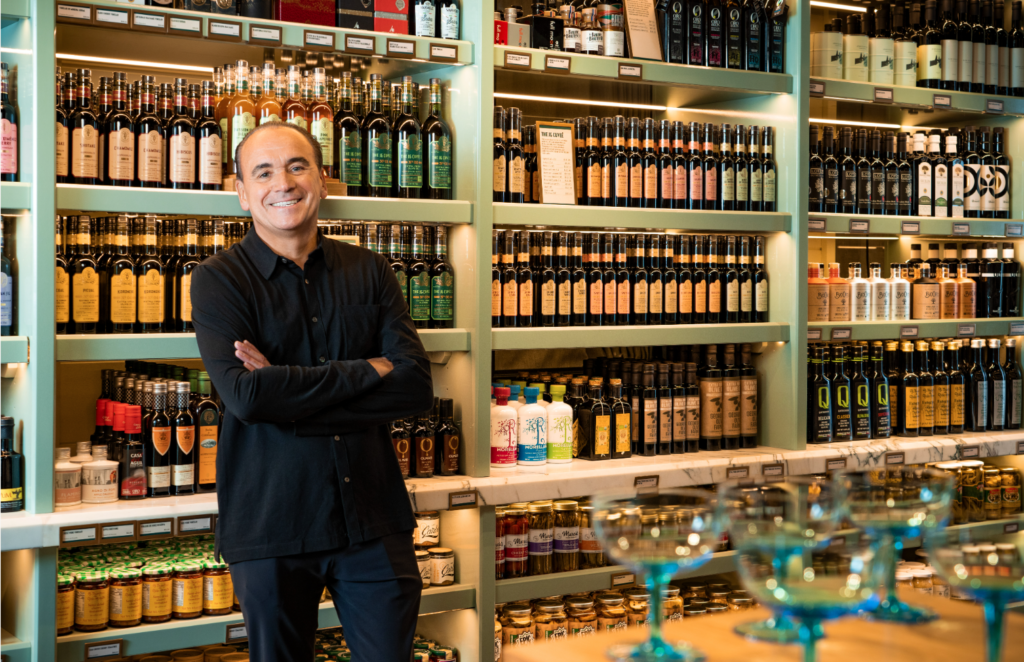
JEAN-GEORGES in front of the oils and vinegars inspired by his mother at Merchantile West. Shirt and pants, his own.
”But that wasn’t enough for the chef who, with his longtime business partner and friend Phil Suarez, has opened a 38-restaurant empire around the world. He was convinced he needed to take on the task of giving a new life to the historic Tin Building, which housed the Fulton Fish Market for nearly a century, from 1907 until it moved to the Bronx in 2005. “It meant something special to me,” he says. “From the very first day I arrived in New York and began working at Lafayette in the Drake Hotel in 1986, I had a connection to this place. I started working one night and at 5 a.m., the very next day, I was down here buying fish for the restaurant,” he continues. “It holds special memories and the chance to. bring it back to life means that much more to me.”
The energetic Frenchman recalls, “You’d see the sun coming up over the Brooklyn Bridge. Fantastic! I was so sad when they moved. I wanted to bring life back to this historic place.”
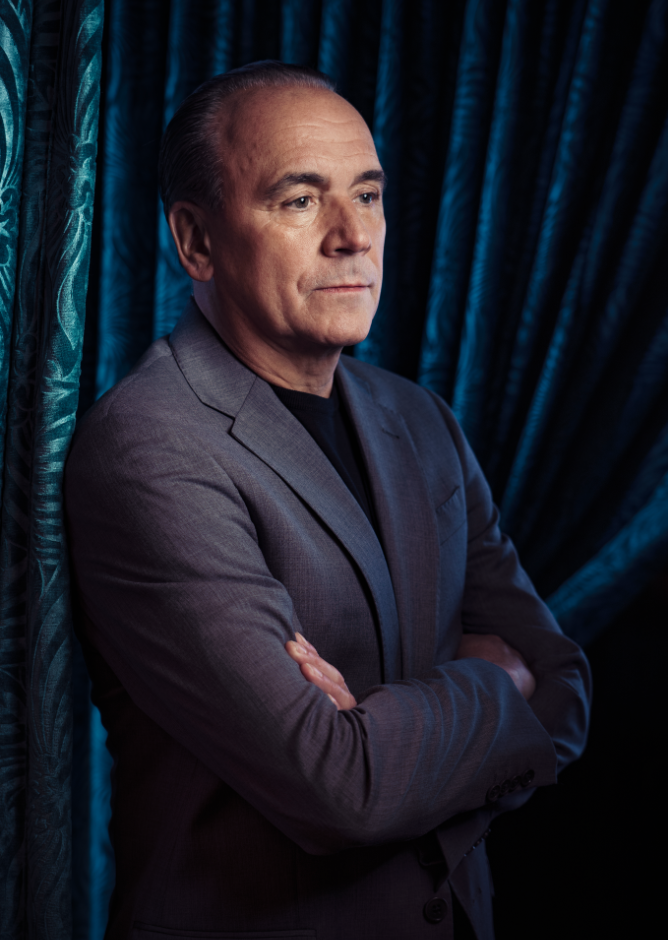
JEAN-GEORGES at the entrance to House of the Red Pearl. Giorgio Armani suit and sweater, armani.com
The Howard Hughes Corporation reached out to the fine-dining icon in 2016 to consult on the project to bring new life to Pier 17, knowing his connection to the history of not just the Fish Market, but the Downtown community he calls home. It was a perfect fit. “I have lived and worked Downtown for so long. I have opened restaurants here and know the history of the area so well. At first, I was just advising on the concepts and interiors for Howard Hughes — but it soon became my passion and focus.”

JEAN-GEORGES in the museum area in front of archival images of the fishmongers taken by Barbara Mensche. UNIQLO crew neck t-shirt. uniqlo.com
The great chef’s memories of the Seaport are colorful—and sometimes indicative of how far the community has come. He recalls, “When I was just starting out, the night manager at Lafayette sent me down to buy fresh fish in his big Cadillac. So, I parked on South Street right across from the market. I got what I needed, and I went back to find the car sitting on four wood crates! Thankfully, it’s a very different place today.” The original historical structure—damaged by fire, flood and neglect—has been completely rebuilt by SHoP architects with many of the original materials. They lifted the structure seven feet to protect from flooding, and simultaneously moved it 32 feet closer to the river. The interiors of the new building were designed by award-winning design firms Roman andWilliams Buildings and Interiors, and Cass Calder Smith. “We were all in,”Jean-Georges said of the monumental task.
His love affair with New York is well-documented and the affection has been returned to him in spades.
Lafayette’s classic French cuisine instantly drew four stars from The New York Times—and he was only 29 at the time. When he stretched himself even further—opening the casual bistro, Jo Jo, and then the Asian-flavored Vong, he racked up even more accolades. By 1997, his New York credentials were cemented in stone, when he threw open the doors to the eponymous Jean-Georges restaurant in the Trump International Hotel andTower, earning a 4-star review fromThe New York Times less than three months later. It’s also earned two Michelin stars, and garnered the chef the coveted Chef of the Year award from John Mariani at Esquire magazine, and the Best New Restaurant award by the James Beard Foundation.
With all those accolades in tow, Jean Georges turned his attention to Lower Manhattan.
His first foray below 14th Street was the venerable Mercer Kitchen on Prince Street in 1998, with its novel American-Provençal menu, warms surroundings and communal tables. He also ventured into the carnival world of Meatpacking with the late and lamented Spice Market in 2004. “I was dying to come Downtown,” he admits. “I live here, and saw it as an exciting place of opportunity where I felt both inspired and comfortable.”
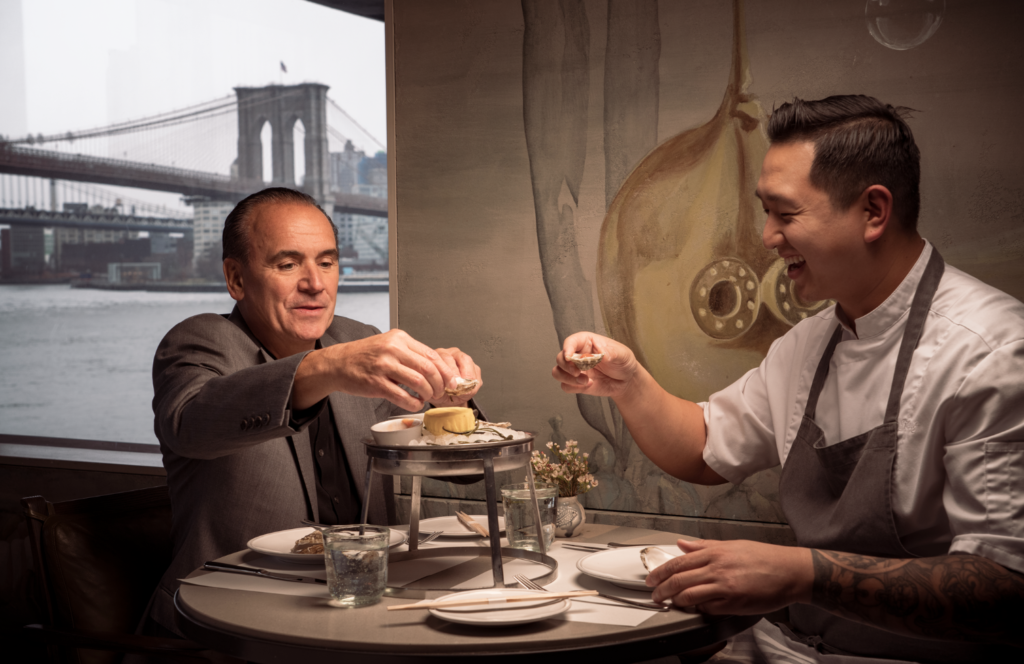
EATING OYSTERS at The Fulton: Jean-Georges and Chef de Cuisine Lei Jiang at The Fulton by Jean-Georges. Giorgio Armani suit, armani.com; shirt, his own.
His commitment to making a presence in Lower Manhattan never wavered, in the face of a series of catastrophes that have beset the Downtown community. Despite the tragedy of the 9/11 attacks on the World Trade Center in 2001, the financial collapse of 2008, and most recently, the global pandemic that emptied the streets and closed businesses in the last three years, he recognized the community’s unending ability to rebound and evolve. “It speaks to the resilience of the people down here,” he says. “You can see it more and more every day. People are coming back businesses are returning, and I believe our success will be an inspiration for even more revitalization around us.”
Renewed vitality is precisely what he serves up in this spectacular culinary playground, which features an unparalleled 21st century market place featuring fresh seafood, meat, vegetables, and an assortment of prepared foods surrounded by a cornucopia of full-restaurant options, providing a full dining experience for families, tourists, and foodies with a fine palate. The chef has admitted that delays caused by the pandemic even provided some benefit as he and his co-visionaries at Roman andWilliams collaborated on the concepts and interiors of the Tin Building. “We took direction from a design perspective of a sort of heyday of the market, the 1920s and ’30s,” says Robin Standefer, principal and co-founder at Roman and Williams, “American Deco spaces that were often about a sort of sanitary, beautiful, utilitarian interior.”
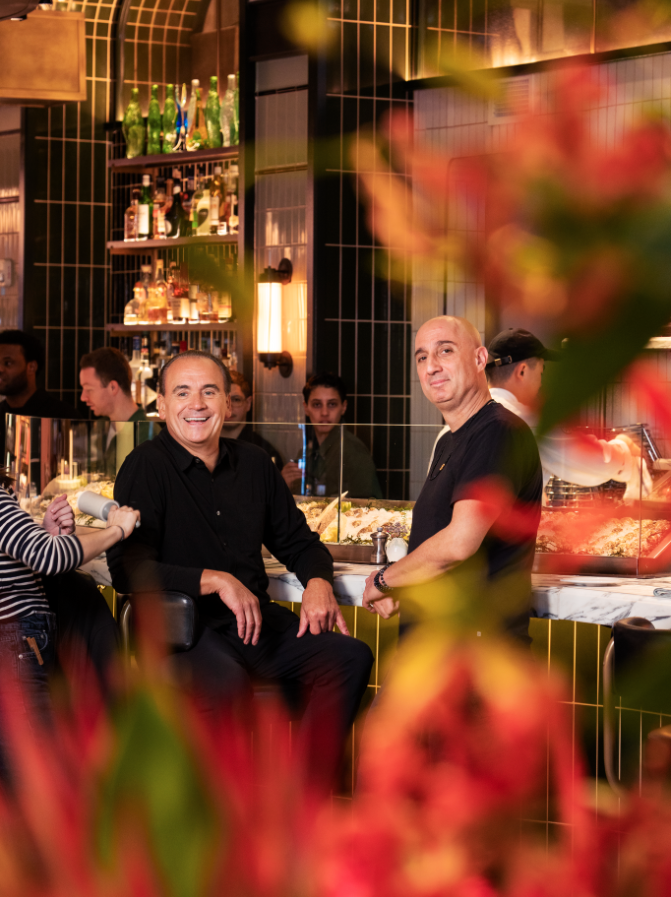
AT THE TIN BUILDING’s FULTON FISH CO. Jean-Georges and Chef Gregory Brainin, executive vice president of culinary development for Jean-Georges Management. Shirt and pants, his own.
Along with its modern amenities, the new market features hand made tiles and brass that are a reflection of Jean-Georges’ admiration for the building and its incredible backstory. “We kept all the columns and as structures,” he says. “It was important for me to preserve the history of the building, while giving it new life.”
The food hall was originally inspired by the Food Halls at Harrods in London but has grown well beyond the original vision. “The food hall [at Harrods has] four or five rooms. We decided to do our market in one area, so you can turn around and buy everything, and [with] many more restaurants.” He explains that he wanted the experience to be far more of a multi-purpose, family and community gathering place, and strolling though the market, you can see he’s accomplished his goals.
Young couples pushing strollers and accompanied by the family dog rub shoulders with foodies hoping to score an array of delicacies and the chef’s own special oils, professionals looking for a place to get away from the office, and people enjoying a relaxed, quality dining experience.
“I wanted to make this place a full-on combination of the old fish market, but with full-dining restaurant options,” he said. “But I wanted it to be more than a traditional market where the doors closed at 8 o’clock.We also wanted them to have a full evening experience and that is readily available in all of the nine restaurant options we offer. And, I wanted it to be as festive and alive as the Boqueria in Barcelona.”
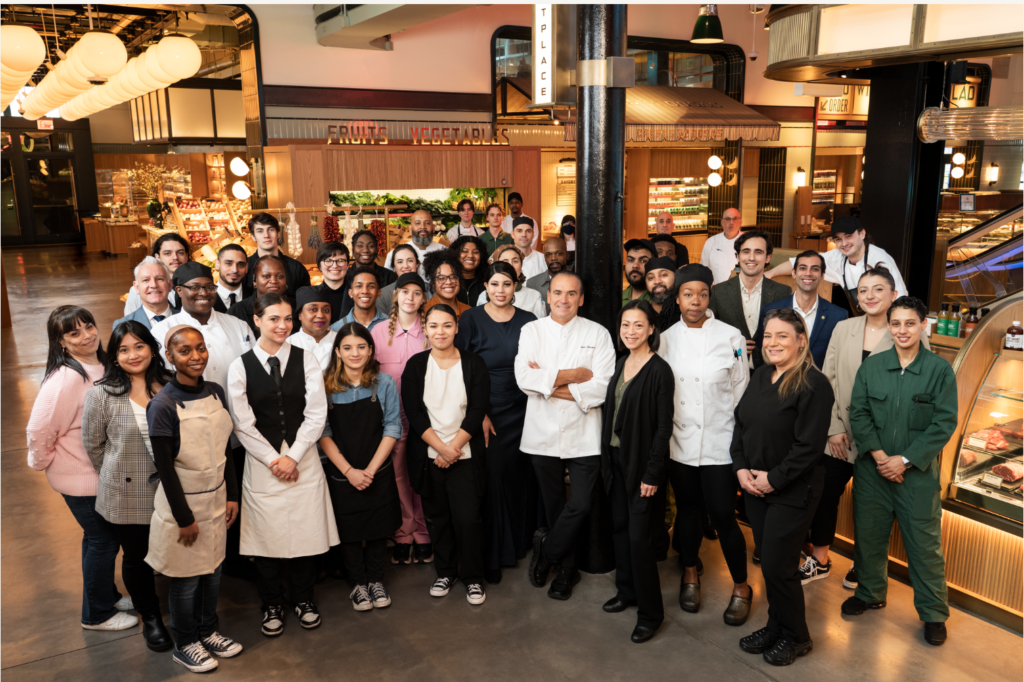
JEAN-GEORGES with some of the Tin Building team.
The fresh ingredients sold at the market counters including live scallops in the shell, day-boat fish and crab from up and down theEast Coast; greenmarket produce from Eckerton Hill and NorwichMeadows farms outside the city—will supply its restaurants, too.“The fish that we buy in the morning will be sold in the market and restaurants that night,” he says. “I want my talented chefs to use this place as their playground.”
For example, Neal Harden of abcV will oversee the plant-based Seeds & Weeds, while Japanese star chef Hiroyuki Sato will contribute to the19-seat sushi bar, Shikku. From The Frenchman’s Dough to The House of the Red Pearl Chinese Restaurant to the Fulton Fish Co. raw bar, and all the rest—virtually every conceivable palate is rewarded with the finest fare in a friendly environment that already feels like a community.
“We wanted it to be a place that you could come and shop, but then stay for a great meal and a fun evening mingling with our many other customers,” Jean Georges says. “The market is brimming with people and we’ve developed restaurants to appeal to their many different tastes.” He adds the almost theme park atmosphere is all inclusive and draws people from all over the world. But he is most inspired by the support he receives from his neighbors here in Downtown.
“This area and these people have been through so much, but they always come back, and the excitement surrounding this place is proof,” he says. DT
Photography by Andrea Fremiotti
Creative Direction by Deborah Dragon
Styling by Kathleen Burns assisted by Adi Giesey
Grooming by Brian Duprey for MAC Cosmetics at Judy Casey.
Location: The Tin Building, at The Seaport, NYC

